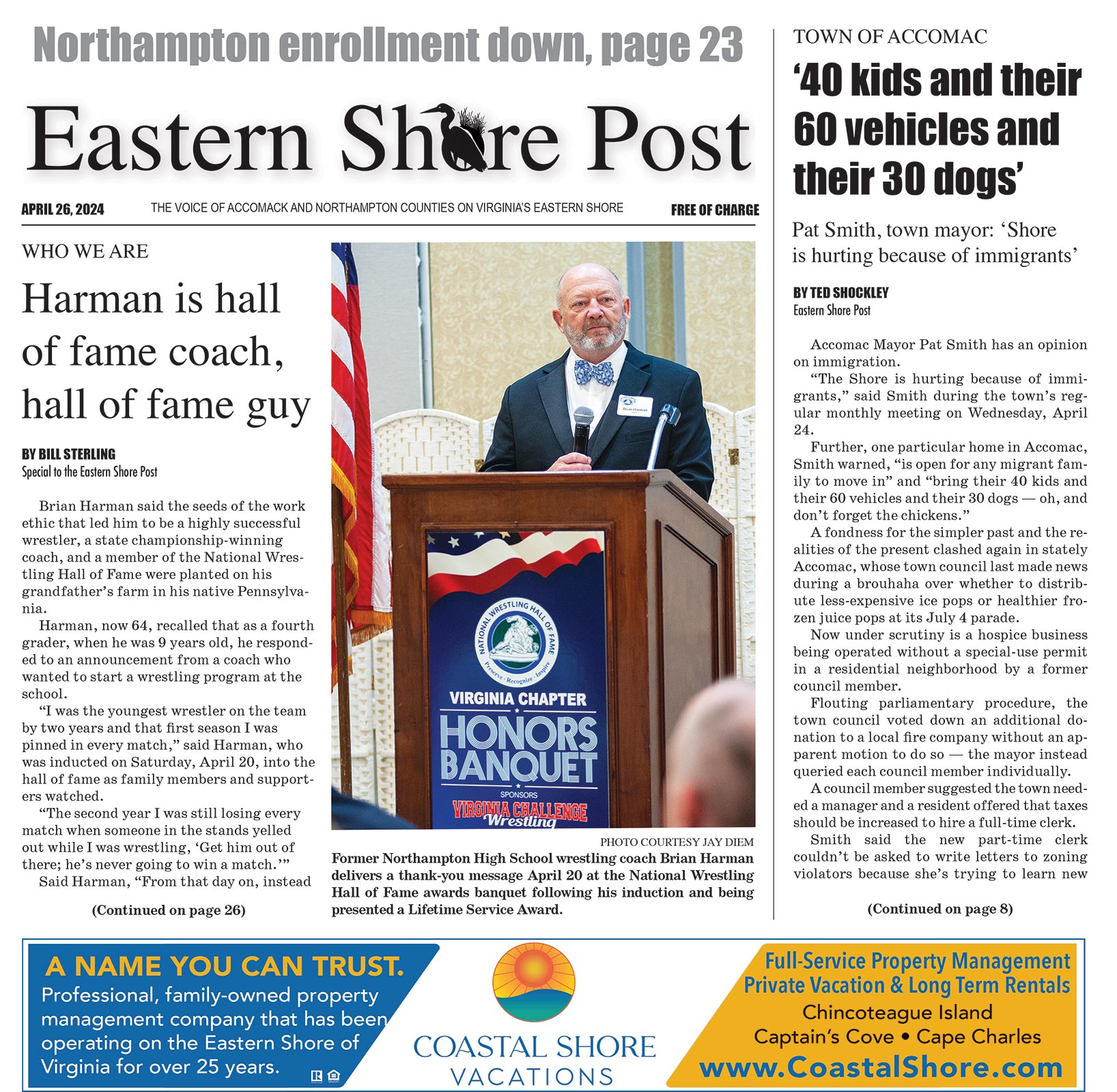Dear Editor:
Without hesitation or reservation, Abel Parker Upshur (1790-1844) should be ranked as the most important person in the history of the Eastern Shore and, in Virginia, in the quarter century leading to the conclusion of the Civil War.
Planter, commonwealth’s attorney, legislator, judge, secretary of the Navy, and secretary of state. Counties in West Virginia and Texas are named after him. Streets in Washington, D.C., and Portland, Ore., are named after him. Mt. Upshur, aka Boundary Peak 17 in Alaska, is named in his honor. A ship (destroyer) was named after him. His portrait hangs in the State Department and at Blair House. Foremost in importance, however, were his writings on the meaning of the Constitution, which were required reading at law schools of University of Virginia and William & Mary for an entire generation.
There is no memorial on the Eastern Shore.
In 1840, Upshur published a treatise in refutation of Associate Justice Joseph Story’s “Commentaries on the Meaning of the United States Constitution,” published in 1833. Upshur’s writings argued the constitutional case for Virginia to secede from the Union in 1860 and Lincoln to resolve the issues of nullification, secession, and confederation vs. a national consolidated union in a Civil War enforcing Story’s meaning of the Constitution.
Joseph Story (1779-1845) was considered the foremost jurist and Constitutional law scholar of his time. His commentaries were based upon his reading of the Federalist Papers and the opinions of Chief Justice John Marshall with whom he had served on the Supreme Court for many years and to whom his work was dedicated.
In Story’s view, the reference to “We the People” in the Preamble to the Constitution means all the people in the United States collectively as one consolidated people. The colonies became states at the time of ratification of the Constitution; the Constitution was not a compact between individual sovereign states as if a confederation, and the Constitution was the supreme law of the United States.
Upshur’s rebuttal, “A Brief Enquiry into the True Nature of our Federal Government,” argued that there was no collective “We the People” from the time of the Declaration of Independence and at the ratification of the Constitution. Upshur argued that each colony rebelled against England independently, established its own constitutions, and declared themselves independent sovereign states as did Virginia in 1775. Representatives they sent to the first Congress (1744) represented only the people of their colony and at the signing of the Declaration (1776). In 1777, representatives signed the Articles of Confederation, decidedly not an agreement to establish a consolidated or national government. Indeed, Article II of the Confederation agreement expressly said signatories were as sovereign states.
When exigencies of the time required the inadequacies of the Articles be addressed, the Congress met and the first draft of the Constitution was reported on Aug. 6, 1787. The Preamble read “We the People of the States of New Hampshire, Massachusetts … (naming each of the 13 colonies/states) do ordain…” and the meaning was the people of each state as individual and sovereign not as one collective or consolidated people. On Sept. 8, 1787, a resolution was adopted to refer the draft of the Constitution to a committee of five to finalize style and order of matter but not to change anything in the meaning of the agreement.
On Sept. 12, the committee reported the changes in style, and on Sept. 18 it was compared to all matters agreed upon. The Preamble read, “We the People of the United States.” However, this was decided because the Constitution required only nine states to ratify and it was not certain all 13 colonies/states would ratify. Thus, all 13 could not be named if one or more did not and it would be presumptuous to enumerate all.
Note: The Preamble is not law. Ratification was by states and the “people” were citizens of the states.
Upshur believed strongly in maintaining the Union but he also asserted the states had the right of nullification and secession. While the Constitution was the supreme law of the land and the Supreme Court the supreme arbiter in enumerated powers, because the Constitution was a compact between the States and the federal government it could not be the arbiter in disputes over nonremunerated powers or dispute between the parties.. Thus, Upshur argued the states had the right to nullify and/or secede.
In the final analysis, the existential reason for Virginia to secede from the Union is found in Upshur’s refutation of Story’s Commentaries. Lincoln had promised that Virginia could remain in the Union as a slave state and he would not introduce a constitutional amendment as required. Indeed, in Lincoln’s first inaugural address, he said “I have no purpose, directly or indirectly, to interfere with the institution of slavery in the States where it exists. I believe I have no lawful right to do so and I have no intention to do so.” However. Lincoln strongly denied the right of secession.
There are those, then and now, who think because Upshur was a wealthy planter and slave owner, his treatise was a prejudice in that property interest. Emphatically no. His and as well Story’s interest was the meaning of the Constitution irrespective of the issue in dispute.
If one would but read Story’s Commentaries and Upshur’s treatise they would understand why both Virginia and Lincoln believed they were fighting a civil war over the meaning of the Constitution, why Lee felt honor bound to serve Virginia and the Confederacy, and why the many memorials to Virginia’s fallen in that great conflict proclaim faithfulness to the Constitution as their cause.
Charles Landis
Onancock



